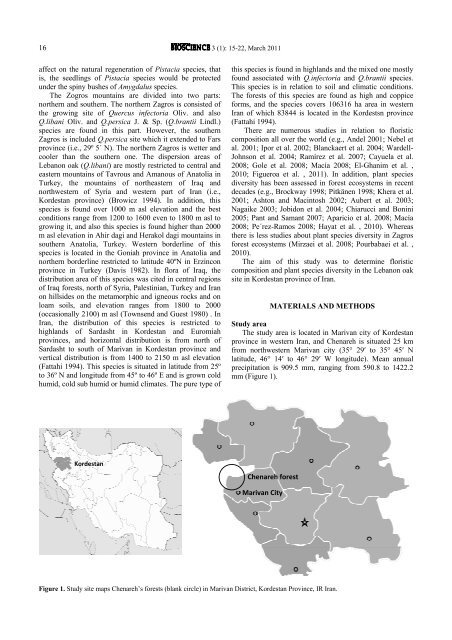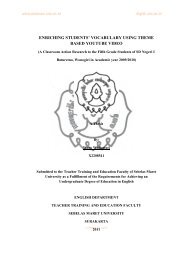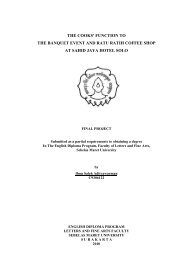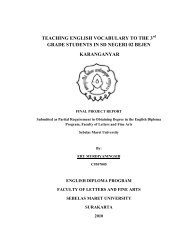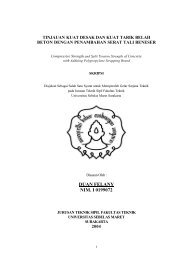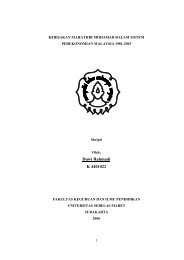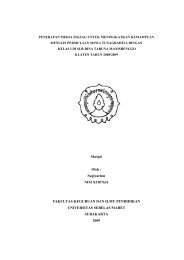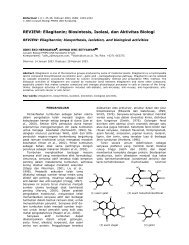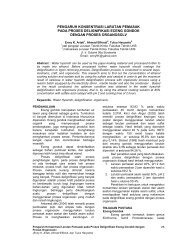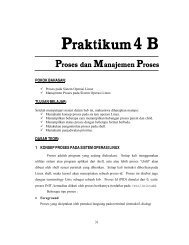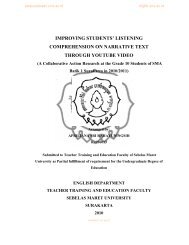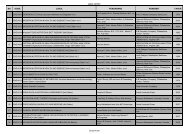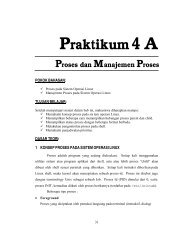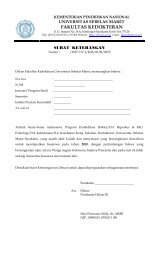ISSN 2087-3940 (PRINT) | ISSN 2087-3956 ... - Biodiversitas
ISSN 2087-3940 (PRINT) | ISSN 2087-3956 ... - Biodiversitas
ISSN 2087-3940 (PRINT) | ISSN 2087-3956 ... - Biodiversitas
Create successful ePaper yourself
Turn your PDF publications into a flip-book with our unique Google optimized e-Paper software.
16<br />
3 (1): 15-22, March 2011<br />
affect on the natural regeneration of Pistacia species, that<br />
is, the seedlings of Pistacia species would be protected<br />
under the spiny bushes of Amygdalus species.<br />
The Zogros mountains are divided into two parts:<br />
northern and southern. The northern Zagros is consisted of<br />
the growing site of Quercus infectoria Oliv. and also<br />
Q.libani Oliv. and Q.persica J. & Sp. (Q.brantii Lindl.)<br />
species are found in this part. However, the southern<br />
Zagros is included Q.persica site which it extended to Fars<br />
province (i.e., 29º 5´ N). The northern Zagros is wetter and<br />
cooler than the southern one. The dispersion areas of<br />
Lebanon oak (Q.libani) are mostly restricted to central and<br />
eastern mountains of Tavrous and Amanous of Anatolia in<br />
Turkey, the mountains of northeastern of Iraq and<br />
northwestern of Syria and western part of Iran (i.e.,<br />
Kordestan province) (Browicz 1994). In addition, this<br />
species is found over 1000 m asl elevation and the best<br />
conditions range from 1200 to 1600 even to 1800 m asl to<br />
growing it, and also this species is found higher than 2000<br />
m asl elevation in Ahir dagi and Herakol dagi mountains in<br />
southern Anatolia, Turkey. Western borderline of this<br />
species is located in the Goniah province in Anatolia and<br />
northern borderline restricted to latitude 40ºN in Erzincon<br />
province in Turkey (Davis 1982). In flora of Iraq, the<br />
distribution area of this species was cited in central regions<br />
of Iraq forests, north of Syria, Palestinian, Turkey and Iran<br />
on hillsides on the metamorphic and igneous rocks and on<br />
loam soils, and elevation ranges from 1800 to 2000<br />
(occasionally 2100) m asl (Townsend and Guest 1980) . In<br />
Iran, the distribution of this species is restricted to<br />
highlands of Sardasht in Kordestan and Euromiah<br />
provinces, and horizontal distribution is from north of<br />
Sardasht to south of Marivan in Kordestan province and<br />
vertical distribution is from 1400 to 2150 m asl elevation<br />
(Fattahi 1994). This species is situated in latitude from 25º<br />
to 36º N and longitude from 45º to 46º E and is grown cold<br />
humid, cold sub humid or humid climates. The pure type of<br />
this species is found in highlands and the mixed one mostly<br />
found associated with Q.infectoria and Q.brantii species.<br />
This species is in relation to soil and climatic conditions.<br />
The forests of this species are found as high and coppice<br />
forms, and the species covers 106316 ha area in western<br />
Iran of which 83844 is located in the Kordestsn province<br />
(Fattahi 1994).<br />
There are numerous studies in relation to floristic<br />
composition all over the world (e.g., Andel 2001; Nebel et<br />
al. 2001; Ipor et al. 2002; Blanckaert et al. 2004; Wardell-<br />
Johnson et al. 2004; Ramírez et al. 2007; Cayuela et al.<br />
2008; Gole et al. 2008; Macía 2008; El-Ghanim et al. ,<br />
2010; Figueroa et al. , 2011). In addition, plant species<br />
diversity has been assessed in forest ecosystems in recent<br />
decades (e.g., Brockway 1998; Pitkänen 1998; Khera et al.<br />
2001; Ashton and Macintosh 2002; Aubert et al. 2003;<br />
Nagaike 2003; Jobidon et al. 2004; Chiarucci and Bonini<br />
2005; Pant and Samant 2007; Aparicio et al. 2008; Macía<br />
2008; Pe´rez-Ramos 2008; Hayat et al. , 2010). Whereas<br />
there is less studies about plant species diversity in Zagros<br />
forest ecosystems (Mirzaei et al. 2008; Pourbabaei et al. ,<br />
2010).<br />
The aim of this study was to determine floristic<br />
composition and plant species diversity in the Lebanon oak<br />
site in Kordestan province of Iran.<br />
MATERIALS AND METHODS<br />
Study area<br />
The study area is located in Marivan city of Kordestan<br />
province in western Iran, and Chenareh is situated 25 km<br />
from northwestern Marivan city (35° 29′ to 35° 45′ N<br />
latitude, 46° 14′ to 46° 29′ W longitude). Mean annual<br />
precipitation is 909.5 mm, ranging from 590.8 to 1422.2<br />
mm (Figure 1).<br />
Kordestan<br />
Chenareh forest<br />
Marivan City<br />
Figure 1. Study site maps Chenareh’s forests (blank circle) in Marivan District, Kordestan Province, IR Iran.


